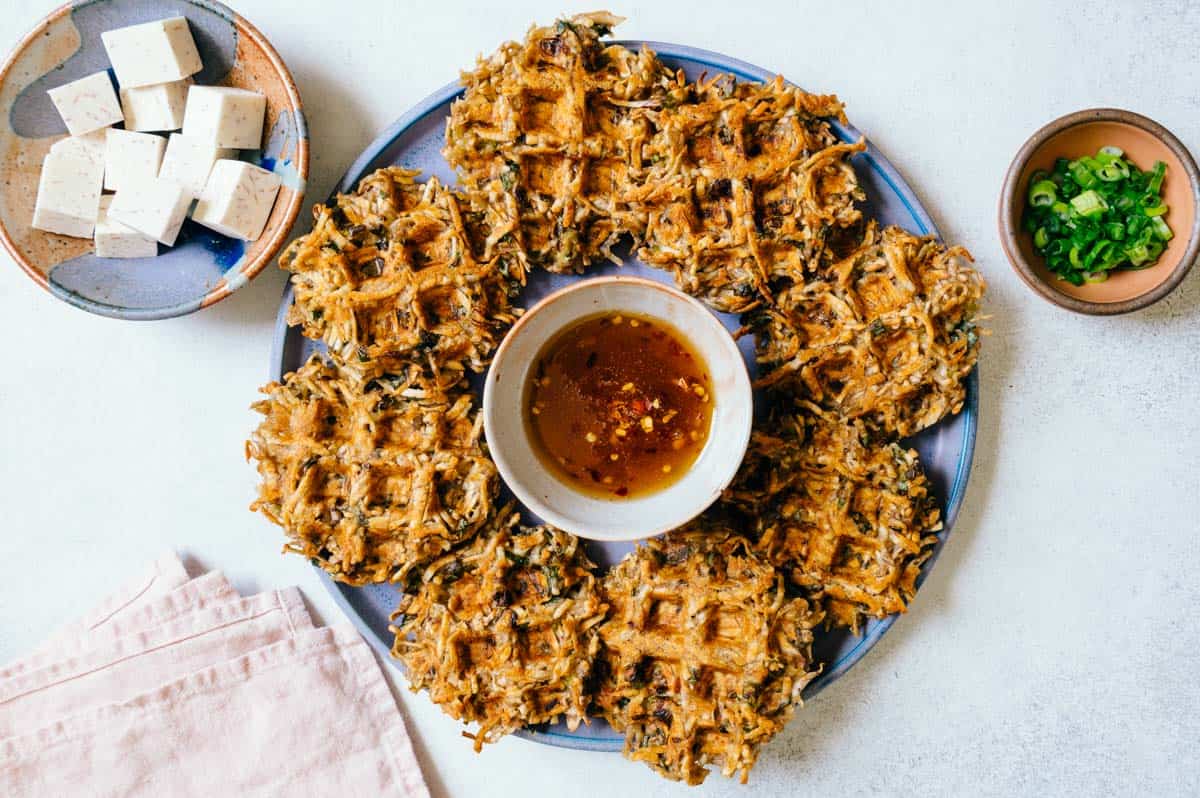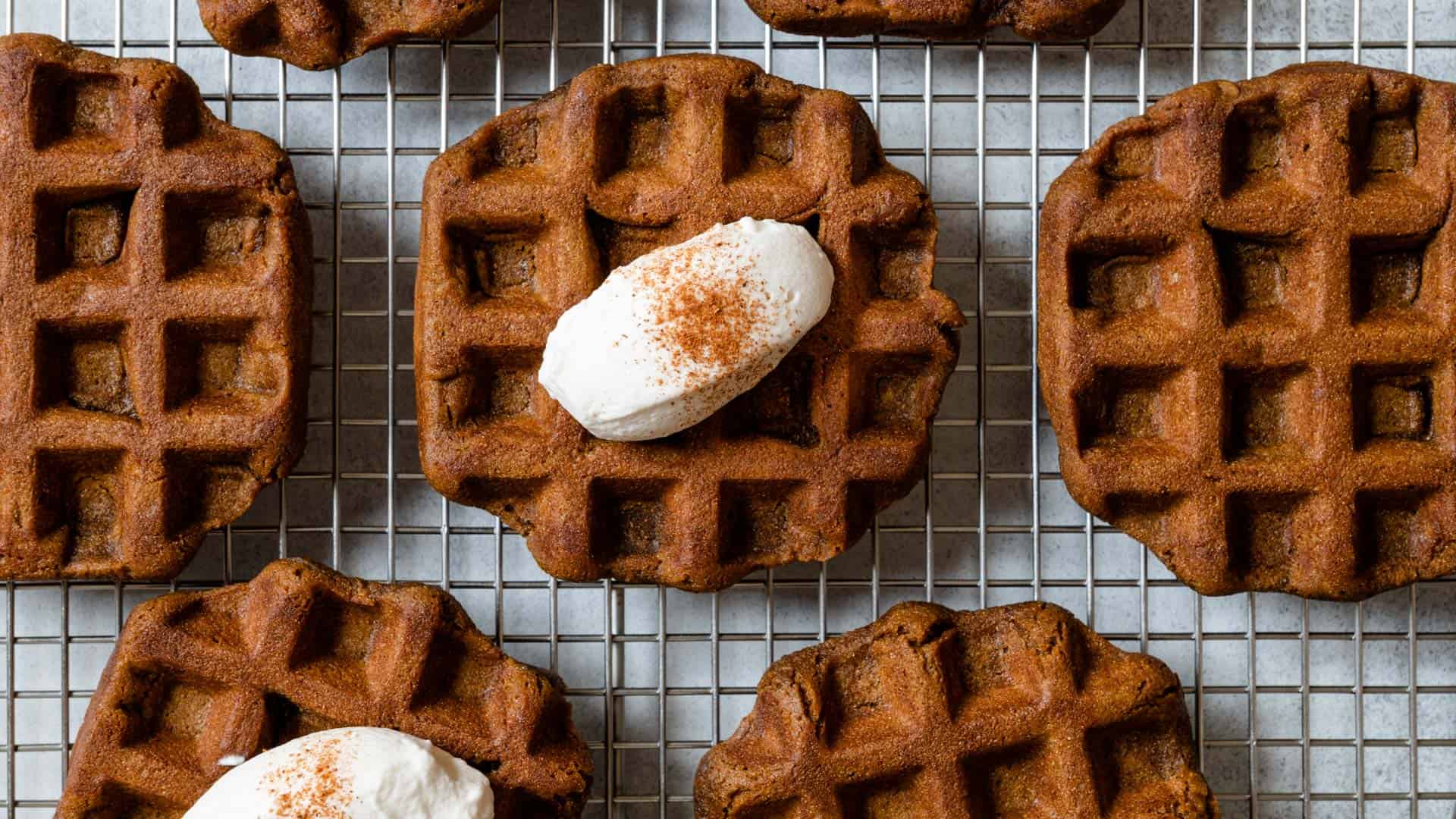

When I was a teenager, I would often come home from school feeling incredibly hungry. There weren’t many snacks in my house, but I could always find packets of instant mashed potatoes that my family bought from Costco. So I cooked these instant mashed potatoes and added sautéed Chinese sausage and onions for more flavor. Eating mashed potatoes while watching the Golden Girls became an afternoon ritual.
As a nod to the culinary adventures of my youth, I made mashed potato waffles with Chinese sausage. I love how the waffle iron creates thin and crisp pockets that contrast nicely with the soft texture of the mashed potatoes. The sliced scallions also give a lovely fragrant flavor to the waffles. These mashed potato waffles are great on their own or served with my sweet chili sauce or any kind of chili crisp!

COOKING NOTES FOR MASHED POTATO WAFFLES
WAFFLE MAKERS
There are so many different waffle irons in the market that come in various shapes and sizes. I typically use this square Cuisinart waffle maker (affiliate link), but many of you likely own a waffle maker of a different brand or shape. Therefore, the cooking times for these different waffle irons might not be the same. Use the cooking times outlined in the recipe as a rough guide. Your waffles are done once they are golden brown.
DON’T USE FRESHLY MADE MASHED POTATOES
Freshly made mashed potatoes are too soft and have too much moisture for this recipe. For crispier mashed potato waffles, it’s best to use mashed potatoes that have chilled in the refrigerator overnight. If you are pressed for time and want to make the mashed potatoes and waffles on the same day, you can make the mashed potatoes in the morning. Then, spread the cooked mashed potatoes over plates and let it chill in the fridge for a few hours before using it to make waffles.
MORE WAFFLE RECIPES

Taro Waffles: These golden taro waffles are packed with earthy and umami flavors. They’re delightfully crispy on the outside and soft on the inside.

Ginger Mochi Waffles: These mochi waffles are perfect for your holiday brunch! I drew inspiration from gingerbread and packed a lot of spices into these mochi waffles.

Mashed Potato Waffles with Chinese Sausage
For this recipe, I used a Cuisinart square waffle maker to cook the waffles. Many of you likely own a waffle iron of a different brand or shape, which means the cooking times might be different. Use the cooking times below as a rough guide.
Ingredients
- 2 1/2 cups (about 560g) leftover mashed potatoes chilled overnight (see note 1)
- 1/2 cup (60g) all-purpose flour volume measured with the spoon-and-sweep method
- 1 teaspoon Diamond Crystal kosher salt or 1/2 teaspoon sea salt
- 1/2 teaspoon granulated garlic
- 1/4 teaspoon ground white pepper can sub with black pepper
- 1/4 teaspoon Aleppo pepper optional (see note 2)
- 1 large egg
- 1/4 cup (60mL) whole milk
- 2 tablespoons olive oil plus more for brushing waffle iron
- 1/2 cup (about 70g) finely chopped Chinese sausage (see note 3)
- 1/2 cup (about 20g) thinly sliced scallions
Instructions
-
In a bowl, mix together the mashed potatoes, flour, salt, granulated garlic, white pepper, Aleppo pepper (if using), egg, milk, and olive oil. Add the Chinese sausage and scallions into the bowl and mix until all the ingredients are well incorporated.

-
Heat a waffle maker at medium heat. Pour some olive oil into a bowl for greasing the waffle iron. Once pre-heated, brush olive oil over the top and bottom plates of the waffle iron.
-
Put some of the mashed potato mixture into your waffle iron. My waffle iron makes 4 small square-shaped waffles, and I use a large cookie scoop to put about 1/3 cup of the mashed potato mixture into each quadrant. If you have a circular Belgian waffle iron, you may want to put more batter in the center to create a larger waffle.

-
Close the waffle maker and cook the waffles for 5 minutes. Open the lid and check the color of the waffles. If they are lightly golden (like you see in the photo below), cook the waffles for another 2 to 3 minutes. If the waffles have barely browned, they’ll need a few more minutes. The bottom plates of my waffle iron run hotter than the top, so I like to flip the waffles after 5 minutes to ensure that both sides are cooked evenly. Cook the waffles until the ridges are golden and the pockets are a rich brown color, an indication that the pockets are crispy.

-
Transfer the cooked waffles to a cooling rack and continue cooking the remaining waffles. Serve them warm with my sweet chili sauce or any kind of chili crisp!

Notes
- Leftover Mashed Potatoes: Freshly made mashed potatoes are too soft and have too much moisture for this recipe. For crispier mashed potato waffles, it’s best to use mashed potatoes that have chilled in the refrigerator overnight. If you are pressed for time and want to make the mashed potatoes and waffles on the same day, you can make the mashed potatoes in the morning. Then, spread the cooked mashed potatoes over plates and let it chill in the fridge for a few hours before using it to make waffles.
- Aleppo Pepper: I added Aleppo pepper for additional spice, but you can leave it out or use a different type of chili flake. Gochugaru works well, but it’s less spicy compared to Aleppo pepper. If you’re using gochugaru, you may want to use 1/2 teaspoon of it (or more) for this recipe.
- Chinese Sausage comes in various sizes. If the sausage is about 1/2-inch in diameter, slice them in half before slicing them into smaller pieces. If the sausages are wider, quarter the sausage before slicing them into small pieces.
- Freezing Directions: If you want to make a big batch ahead, freeze the waffles on a sheet pan or large plates. Once frozen, transfer the waffles to a freezer bag. To reheat the waffles, bake them at 400ºF (205ºC) for 6 to 8 minutes.
- Nutrition Information: Since we’re all using different recipes to make the mashed potatoes and brushing the waffle iron with varying amounts of oil, it’s difficult to calculate accurate nutrition information. Use the information below as a rough guideline.
Nutrition
The post Mashed Potato Waffles with Chinese Sausage appeared first on Healthy Nibbles by Lisa Lin.






